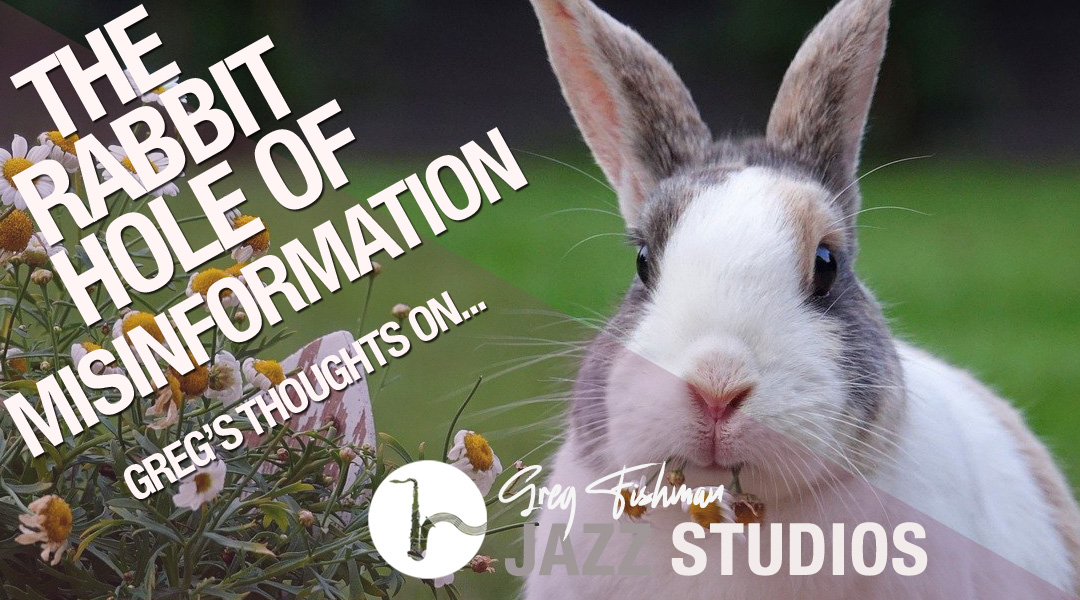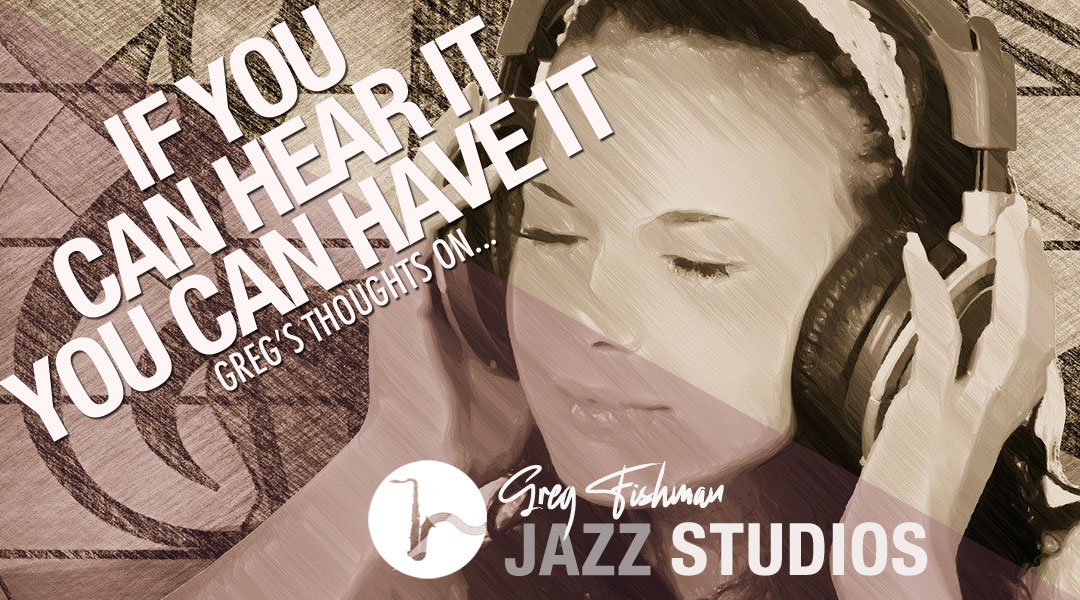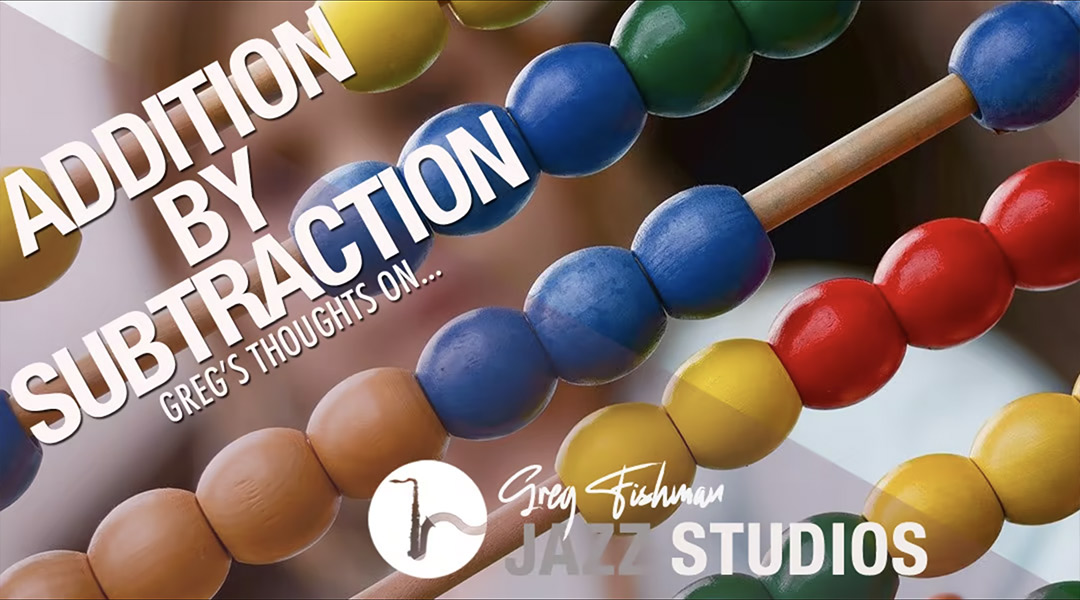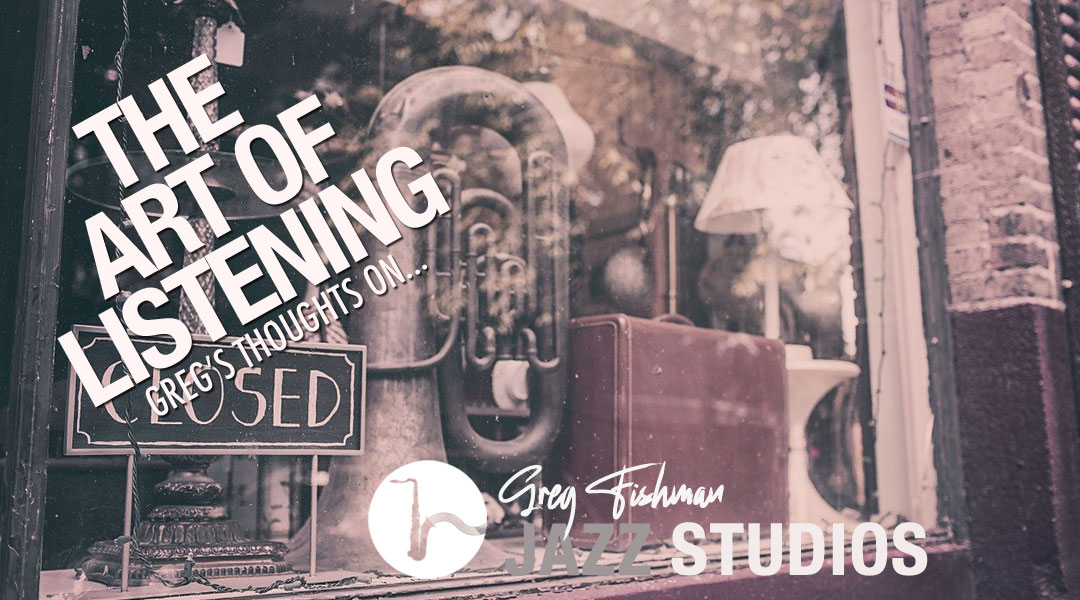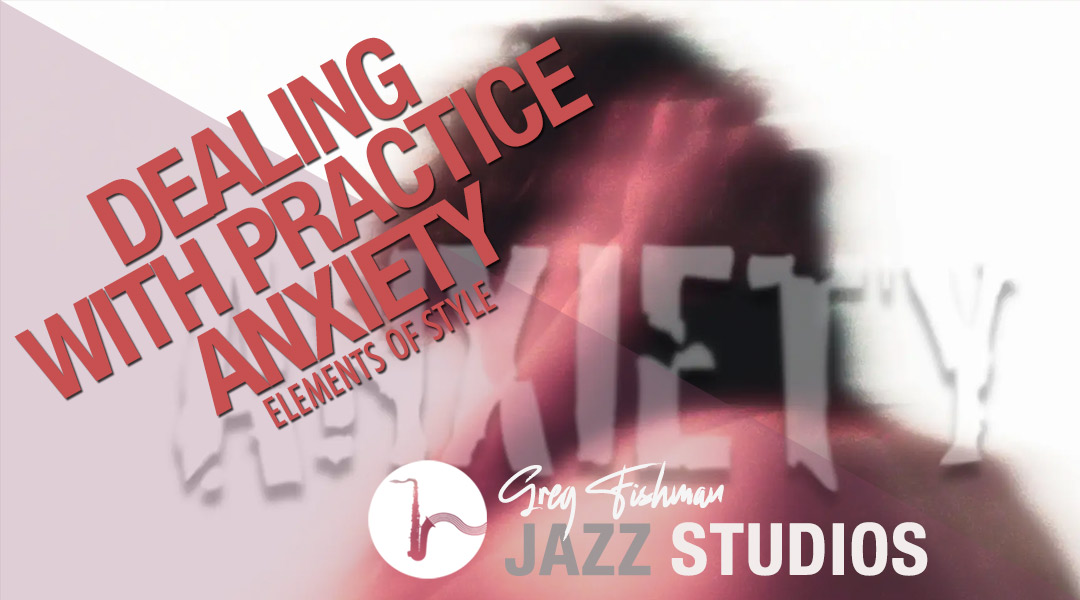Lessons from the Bandstand – John Young
The Car Analogy – Sounds vs Theory
The Car Analogy – Sounds vs Theory
Escaping the Conscious Mind of Theory
Escaping the Conscious Mind of Theory
The Rabbit Hole of Misinformation
The Rabbit Hole of Misinformation
If You Can Hear It You Can Have It
If You Can Hear It You Can Have It
Addition by Subtraction
Addition by Subtraction
The Art of Listening
The Art of Listening
Dealing with Practice Anxiety – How to Have Fun While You Practice
Dealing with Practice Anxiety – How to Have Fun While You Practice
Greg’s Philosophy of Music: It’s Bigger than You and Me
Greg’s Philosophy of Music: It’s Bigger than You and Me
Lessons from the Bandstand – John Young
Lessons from the Bandstand – John Young
The Car Analogy – Sounds vs Theory
The Car Analogy – Sounds vs Theory
Escaping the Conscious Mind of Theory
Escaping the Conscious Mind of Theory
The Rabbit Hole of Misinformation
The Rabbit Hole of Misinformation
If You Can Hear It You Can Have It
If You Can Hear It You Can Have It
Addition by Subtraction
Addition by Subtraction
The Art of Listening
The Art of Listening
Dealing with Practice Anxiety – How to Have Fun While You Practice
Dealing with Practice Anxiety – How to Have Fun While You Practice
Greg’s Philosophy of Music: It’s Bigger than You and Me
Greg’s Philosophy of Music: It’s Bigger than You and Me
Module 58
LESSON 1: The Maj7b5 Chord Echo Game – Part 1 of 2
In this video lesson, I introduce you to the maj7b5 chord structure in the form of an echo game. This is one of my favorite chord structures. It has a fresh, clean sound because of the intervals created by the flatted fifth.
I first became aware of the structure when listening to Joe Henderson, but I’ve also heard many jazz pianists use it to create melodies and left-hand chord voicings. This chord structure is a musical breath of fresh air for your ear, which is used to hearing only major or minor thirds in arpeggios.
You might be tempted to write these chords out, but I recommend that you learn this by ear to really internalize this new sound on a deep level.
LESSON 2: The Maj7b5 Chord Echo Game – Part 2 of 2
In this video lesson, I take a concert Cmaj7b5 chord structure and show you how to place it over multiple harmonic settings.
I explain how to use the maj7b5 structure as upper extensions when practicing your chords on the saxophone. Be sure to check out the “Dr. Jeckyll / Mr. Hyde” analogy with the chord at the 5:30 mark in the video.
LESSON 3: The Maj7b5 Chord – Piano Perspective
In this video lesson, I work with the maj7b5 chord at the piano to help you hear the structure clearly in terms of piano voicings over six different chords.
I explore the intervals used in the structure and also explain the piano voicings commonly used with this chord structure.
Includes PDF practice notes for Bb, C and Eb instruments.
LESSON 4: Trading Choruses and Fours on Satin Doll with Greg
When I grew up in Chicago, I learned so much by sitting in at clubs and trading choruses and fours with the more seasoned players in town. I would try and pick up on the older player’s “vibe” and sometimes continue his idea. It was like we were having a musical conversation.
I wanted to share some of that old-school approach with you in this video lesson. I’m accompanied by world-class pianist Judy Roberts. We play Satin Doll and you can trade choruses and 4’s with me. This is a really fun one! Don’t look at any chords. Use your ear. Watch me and listen and trade with me when it’s your turn. Try to really stay in the moment with me and Judy as we play this classic tune.
LESSON 5: Lessons from the Bandstand – John Young
In this video lesson, I share a story about working with the legendary Chicago pianist, John Young. This is a valuable real-world lesson about listening and interacting with the players on the bandstand.
Module 56
LESSON 1: How to Hear Melodies in Harmonic Context
One of the biggest challenges facing the aspiring saxophonist is learning how to hear a melody as it relates to the underlying chord progression. In particular, the relationship of the melody notes to the underlying root movement (bass notes) is essential for successfully hearing whether a melody note is a 3rd, 5th, 7th, etc.
For example, if the melody is playing a “B” natural, and no chord is heard underneath the note, that “B” is undefined, harmonically speaking. However, if you hear an E in the bass, that “B” now has a clear identity as the 5th of the chord.
In this video lesson, I share a technique for adding the bass notes to the melody and combining these two elements to help players hear this important relationship. I also share some additional strategies for memorizing chord progressions, though singing the bass notes while singing the chord names.
Includes PDF practice notes for Bb, Eb and C instruments.
LESSON 2: Coltrane & Stitt Highlight Major 2nds over V7b9 Chords Category: Elements of Style / Interval Studies
In this video lesson, I explore the way that both Coltrane and Stitt highlight major second intervals in the diminished scale when playing over a V7b9 chord.
In addition to Coltrane and Stitt, many of the old-school jazz players preferred to highlight this particular interval when playing over a V7b9 chord, because this interval is pleasing to the ear, highlighting a sort of musical “sweet and sour sauce,” with the following note combinations: 13 & 5 / #11 & 3 / #9 & b9 / and Root & b7. This approach will help you to dial in very specific color combinations as you solo over the V7b9 chord.
Includes PDF practice notes for Bb, Eb and C instruments.
LESSON 3: Exploring Hip Lick #59
In this video lesson, I’ll explore Hip Lick #59 from my book, “Hip Licks for Saxophone, Volume 1.” This is a Dmi7 lick (tenor key) that combines three common elements to form the two-measure phrase. I break the lick down into each of these component parts and conclude the video lesson with the “Echo Game” (by ear) in 12 keys.
LESSON 4: The Car Analogy – Sounds vs Theory
In this video lesson, I share a new analogy that has been resonating with many of my Skype students. Although I’ve so often mentioned the importance of playing by ear and not just relying on music theory, this analogy, describing theory as license plates and sounds as cars will really help you to get the big picture on the differences between the ear approach and the theoretical approach to music.
Module 51
LESSON 1: Randomized Minor 3rds Echo Game with the Vibes
In this video lesson, we’ll play the echo game with minor 3rds in the four directions, but also, they’re randomized.
This was one of my main ear-training strategies in my early 20s as I was developing my teaching method. It’s challenging but fun, and it will yield great results.
Why the vibes? The vibes provide a clear, bell-like tone that rings for a long time. I have found this to be excellent for helping players internalize the sounds of the pitches….The notes will still be ringing while you try to match the pitch.
This will allow your ear to compare the ringing pitch of the vibes with the sounds coming out of your horn, and you’ll learn to adjust to match the vibes very quickly.
LESSON 2: Cannonball Adderley: ii mi7- V7 – Melodic Genius Phrase
In this video lesson, I explore the opening phrase of Cannonball Adderley’s classic solo on Autumn Leaves. It’s a iimi7 – V7 phrase – Ami7 to D7 in alto key.
This is a masterpiece of melodic efficiency and beauty. Follow the video by ear and play along with me to learn this essential phrase of classic jazz vocabulary from Cannonball.
Includes PDF Practice notes for Bb, Eb and C instruments.
LESSON 3: Escaping the Conscious Mind of Theory
In this video, I share my thoughts about escaping the conscious mind of theory and playing at the speed of sound. Many aspiring players seem to only play as fast as they can mentally calculate the correct notes for a scale, chord, or phrase.
I’ve even encountered pro players who have come to me for help, telling me that they just can’t stop thinking about theory as they play. I used to play that way, but it was very limiting and musically frustrating.
However, I discovered that if I played very fast, my conscious mind couldn’t keep up and didn’t even try. This freed me up to focus on the sound I was hearing, as opposed to the theory I had been thinking.
Once I felt what it was like to play by ear, with my fingers responding to the sound, it felt like I had an aural awareness of the chords as I played (at any tempo), without having to think mechanically through the spellings and theory.
This is not to say that you don’t need to know music theory. You do need to know your scales and chord spellings but think about this in terms of spoken language…You’re not spelling out words in your mind and diagramming sentences while you have a fast conversation with a close friend.
The music should be the same way…you need to break free of those chord and scale spellings and play by sound (ear). Since this involves high-speed playing, I also discuss some of my concepts of hand and finger relaxation so that you can learn to play at high speeds without injuring your hands, wrists, and arms.
LESSON 4: Major 6/9 Chord Voicing with 4ths
I’ve had many questions from students about major 6/9 chords, versus C maj7 chords. In this video, I discuss the differences between the two chords, as well as the similarities.
This chord voicing utilizing 1-3-6-9 is a piano voicing that I like. It has a fresh, open sound when played on the saxophone, and it’s a nice contrast to hearing the more common chord voicings in thirds used by most saxophonists. Includes two echo games — one with maj7 and major 6/9 chords for your ear to compare the two sounds, followed by an echo game with just the new voicing.
Module 48
LESSON 1: Steak & Parsley aka: Evolution of a Lick
In this video lesson, I show you a concept that I call “The Steak and the Parsley.” I explain the difference between the main notes of a lick (the steak) and the ornamental notes of the lick (the parsley). I
present the lick in a step-by-step manner that shows the evolution of the phrase.
Includes detailed PDF practice notes for Bb, Eb, and C instruments.
LESSON 2: Hearing Like a Piano Player – Cycle with 7-3
In this video lesson, I share my strategy for hearing like a piano player.
A jazz pianist is always at a harmonic advantage over a horn player because they can use their left hand to play the bass notes (or full chords) to provide harmonic context for anything they play in their right hand.
I developed my own way to approximate this pianistic approach to hearing in context by playing a bass note in the low register of the horn and then jumping into the high register of the horn with the voice-leading notes.
This is a fun way to train your ear and also gain incredible flexibility on the horn with large register skips.
Includes PDF practice notes for Bb, Eb and C instruments.
LESSON 3: The Cat Water Fountain – Ear Training Echo Game
In this video lesson, I use one of my teaching analogies that I call the “cat water fountain.”
Think about a d versus a cat. A dog is happy with water that has been sitting in the same bowl all day.
A cat wants freshwater, which lead to the popularity of cat water fountains which recirculate the water, making the water mo appealing to the cat.
The ear is like the cat. It can get tired of hearing the chords played in the same way t many times.
This lesson shows you how I keep things fresh for my ear with some unusual variations to my usual chord practice routine.
LESSON 4: The Rabbit Hole of Misinformation
In this video, I share my thoughts about what I call the “rabbit hole of misinformation.”
When I started teaching in the 1980’s, people studied with a teacher and took their advice about what to practice and how to practice. There was no internet and no YouTube.
In a way, this was a good thing, because the students would stay on-track with a good teacher’s guidance. However, in today’s society, there’s YouTube, and anyone can create their own channel with their own teaching videos.
Some of the videos are excellent, made by fine teachers and players, but many are made by unqualified people who are simply sharing their uninformed opinions.
The trick is to be able to tell the difference between the useful videos and the videos that will lead you down the rabbit hole of misinformation.
Module 45
LESSON 1: Tools of the Composer – Jerome Kern’s “I’m Old Fashioned”
In this video lesson, I share my interpretation of a very powerful editing device used by Jerome Kern on the bridge of his famous standard, “I’m Old Fashioned.”
Kern takes something that would have been a very ordinary scale two-note pattern in thirds and transforms it into a memorable melody by editing out one of the notes in the pattern. T
his lesson explores this editing technique and shows you how to apply the concept in your own playing. Includes PDF practice notes for C, Bb and Eb instruments.
LESSON 2: Tools of the Composer – Antonio Carlos Jobim’s “One Note Samba”
In this video lesson, I share my interpretation of Jobim’s use of common tones in the melody over the first four measures of his hit song, “One Note Samba.”
Jobim uses what I call “dual citizen notes” (common tones) to bring out four different flavors from the same repeated note. He achieves this effect by maintaining a repeated pitch in the melody while the chords move downward in half-steps.
I explore this sound and share my approach to transfer this very cool sound to the saxophone. Includes PDF practice notes for Bb, Eb and C instruments.
LESSON 3: Maj7#5 Chords w/Echo Game
In this video lesson, I share my strategy to help a student to the first two chords on the bridge of the popular Brazilian tune, The Girl From Ipanema. I use two upper structures to bring out the sound of the progression.
The first is the very familiar mi7 chord. I use the mi7 chord over the maj7, acting as a 3-5-7-9. Then, I simply lower the root of the mi7 chord to achieve a maj7#5 chord shape. I use the maj7#5 chord shape as 7-9-#11-13 over a dominant chord.
While this may sound complex, it’s very easy for your ear to hear the musical logic of this approach. Includes PDF practice notes for C, Bb and Eb instruments. Echo Game starts at 7:48 into the video lesson.
LESSON 4: If You Can Hear It You Can Have It
In this video lesson, I share a story about a new Skype student who has a music degree and great reading skills, but his ability to play what he hears is not yet fully developed.
After speaking with him about his training, he revealed to me that his former teacher told him to never listen to the sounds in his head and instead, to play by memorizing numbers for the notes. This is contrary to what I learned from Joe Henderson, James Moody, Mark Colby, and all of the many incredible teachers who shared their knowledge with me.
I explain in the video that it’s not just about hearing the sounds, but developing your musical memory and improving your ability to focus on the music.
Module 43
LESSON 1: The Donkey
In this video lesson, I share my system to develop a strong, consistent tone when changing from the upper register to the lower register. The video lesson focuses, especially on slurred descending octaves.
I explain a common problem of aspiring saxophonists dropping their jaw to get to the low register, which causes a pitch drop to the upper note, as well as a weak sounding lower register. I call this problem, “the donkey” because the sound reminds me of a braying donkey.
This is an essential lesson for tone development. Key elements in this lesson include a discussion of jaw positioning, throat tension, and air support. ESSENTIAL FOR ALL LEVELS.
LESSON 2: TUNES
In this video lesson, I share with you the basic bebop style blues changes that my famous Chicago teacher, Joe Daley showed be when I was studying with him in the 1980s. These are what I consider to be essential blues changes for bebop era blues heads, like Billie’s Bounce, Tenor Madness, Now’s the Time, etc.
There are many advanced options for the blues, but this video will provide you with the essentials to get started. I play the progression slowly, with the chords in all four directions. I also take you through singing the roots of the chords while playing the changes on the keyboard. Includes PDF with these changes for C, Bb, and Eb instruments. Intermediate level.
Includes detailed PDF practice notes for C, Bb, and Eb instruments.
LESSON 3: Mi(maj7) Chords with Echo Game in Four Directions
In this video lesson, I explain how to play minor(maj7) chords. This is one of my favorites. it has a kind of “film-noir” quality to the sound of the chord, with a dark minor third, a neutral perfect fifth, and a very bright major seventh. I often refer to this chord as the “Vertigo” chord because this sound was featured so prominently in Alfred Hitchcock’s classic film “Vertigo,” starring Jimmy Stewart.
This chord is also featured in songs such as: Harlem Nocturne, Nica’s Dream, Chelsea Bridge, Solar, and many more. I take you through the “echo game” in all four directions, with Direction 1 at 2:16, Direction 2 at 4:00, Direction 3 at 5:36, and Direction 4 at 7:10. Starting at 8:08 I have a high-speed echo game for advanced players. At 10:48 I give suggestions for practicing with this chord.
Includes PDF for C, Bb, and Eb instruments.
LESSON 4: Addition by Subtraction
In this video lesson, I share my thoughts on transforming your playing not by adding more and more layers to what you’re doing, but by subtracting things that are holding you back. This is a very powerful concept. Who would have thought you could sound so much better by simply subtracting a few things from your playing?
Module 42
LESSON 1: The Echo Game – Major Seventh Chords with Lower Neighboring Tones
In this video lesson, I play the echo game with major seventh chords, adding lower neighboring tones to the root, third, fifth or seventh. Includes directions one, two and a bonus round of direction three for advanced players.
LESSON 2: The Diminished Scale over a Cº7 Chord – New System
In this video lesson, I share a completely new approach to learning the diminished scale for use with the diminished seventh chord. This is one of the more challenging topics, as aspiring players are often unsure about the notes in between the chord tones of 1-b3-b5-bb7 when playing this scale. This new system eliminates all doubt and will help you to hear the scale with clarity.
Includes detailed PDF practice notes for C, Bb and Eb instruments.
LESSON 3: Major Scales in 3rds Shifting by Half Steps
In this video lesson, I take the familiar practice routine of playing major scales in thirds and put a new twist on it. To improve technical fluency in difficult keys, I shift the exercise both a half-step up and down. This is a great way to get over any inhibitions about playing in tricky keys.
Includes detailed PDF practice notes for C, Bb and Eb instruments.
LESSON 4: Staccato Articulation Strategy – Aka: Duck, Duck, Goose
In this video lesson, I share my unique approach to creating extremely percussive short notes similar to the style used by Stan Getz on many of his famous Bossa Nova recordings. This simple, yet effective approach will definitely transform your short notes.
LESSON 5: The Art of Listening
In this video lesson, I share my thoughts about being aware of your musical surroundings at all times. The first story is about a student with no awareness that he’s playing in the wrong key with a play-along. The second story is about a pro player how he was ignoring his musical surroundings. In both cases, it was a failure to listen that hurt both performances. I discuss the importance of developing the ability to listen and play simultaneously.
Module 41
The Echo Game with Lick #1 Variations
In this video lesson, we’ll play the echo game, in which you will imitate or “echo” whatever I play. I have the metronome at 160BPM and play many variations on Hip Lick #1. Each of my demonstration phrases is one measure in length. You’ll have one measure to play the echo, by ear.
The video is divided into two parts. The first part of the video is intermediate level, with all variations on the lick remaining in the same key. The second half of the video takes all of the variations for the echo and puts the lick into the cycle, playing different variations in each of the twelve keys. This is an ear-training video designed to improve your musical memory. So, by intent, there are no PDF notes for this lesson. INTERMEDIATE & ADVANCED LEVEL.
LESSON 2: Stop Scooping Your Notes!
I think of this video lesson like a public service announcement for all intermediate level aspiring player. In my earliest playing days, I was a guilty of this as anyone. I thought it sounded “jazzy” so scoop into my notes. Wrong! Thanks to my old teacher Joe Daley, who told me in quite harsh terms, but really cured me of doing this, I found a better way, through Sonny Stitt, to get the effect of sliding into a note while maintaining the pitch center of the note.
This video demonstrates how it sounds when scooping and then how it sounds when applying the Sonny Stitt way of using a grace note from a 1/2 step below, to slide into a note. Totally hip. This is designed to be an ear-training lesson, as well, so there are no PDF notes with this one. INTERMEDIATE LEVEL.
No PDF materials for this lesson
LESSON 3: The Bad Toupee Theory – How to Blend Licks into a Solo
In this video lesson, I share what I call my “Bad Toupee Theory.” The basic idea is this: Nobody points to a guy and says, “what a great looking toupee!” They only say “look at that bad toupee on that guy!” If it’s a great looking toupee, you can’t even tell that the guy is wearing a toupee. It’s similar with licks.
You don’t want to make it obvious that you’re using licks. They need to blend into the musical surroundings. In this video, I demonstrate an obvious usage of a lick (bad toupee) and I also demonstrate a subtle way to use a lick, blending it into the development of the solo. Includes PDF lesson notes for Bb, Eb and C instruments. INTERMEDIATE & ADVANCED LEVEL.
LESSON 4: Dealing with Practice Anxiety – How to Have Fun While You Practice
Recently, I’ve been hearing more and more from students of all levels who tell me that they’re constantly stressed out about practicing. They feel overwhelmed and anxious about the amount of musical material they need to master in order to move forward. I used to have these feelings, and it took me a long time to change my attitude and approach turn my practice sessions into really fun experiences. I
n this video lesson, I share my personal journey with you and give you some suggestions that, to this day really help me have fun in every practice session. BEGINNING, INTERMEDIATE & ADVANCED LEVELS.
Module 36
LESSON 1: Mirrored Intervals
In this video lesson, I share a concept that I call “mirrored intervals.” By this terminology, I’m referring to the sound of playing, let’s say, an E up to a G, and then playing the same E again, but dropping to the G below. The result is that you’ll go up a minor third and the “mirrored” interval produced when you drop down to the G below E will be a major sixth. One of my favorite players, Gene Ammons uses this device quite a bit in his solos. In this lesson, I’ll demonstrate several ways to practice this concept and get it into your playing. Intermediate & Advanced level. Includes detailed PDF practice notes for Bb, Eb and C instruments.
LESSON 2: Fixing the Break: How to play smoothly from C to D
One problem for many aspiring saxophonists is “the break,” which is the part of the horn that switches from the lower register, without the octave key, to the upper register, with the octave key. The break can be especially challenging when going from middle “C” to middle “D.” The thing that many aspiring players don’t realize is that while there’s just one key to press on the horn, there are actually two octave keys. One is located on the neck, and the other is located on the body of the horn. In this video lesson, I demonstrate both the problem and the solution. Includes close-up camera shots of my hands as I play the horn. If you’ve ever wanted to smooth out your transitions from the low register to the middle register of the horn, this video will immediately put you on the right path.
CLICK HERE to download PDF lesson materials
LESSON 3: The Harmonic Minor Scale
In this video lesson, I demonstrate the harmonic minor scale, first comparing it to the major scale, and then showing how to use it strategically over a minor ii / V / I. I also demonstrate the scale in 3rds in the four directions, followed by an improvisation on the scale. Includes detailed PDF practice notes for Bb, Eb & C instruments. INTERMEDIATE LEVEL.
LESSON 4: Greg’s Philosophy of Music: It’s Bigger than You and Me
In this video lesson, I discuss my thoughts about a student who came to me feeling down about his playing. He is a good student. He practices a lot. He always shows up prepared for the lessons. I’m proud of his progress. And yet, he had such negative feelings about his playing that he was considering quitting.
I shared my personal philosophy about music with him and told him about my own experience with feelings of frustration and self-doubt as a younger player. After I shared these thoughts with him, we proceeded to have a fantastic lesson and by the end of the lesson, he was feeling much better about things. I hope that you enjoy the video.
LESSON 5: Listening Recommendation: Cannonball Adderley – Somethin’ Else
An all-time classic 1958 Blue Note album. Miles Davis rarely appeared as a sideman after his time with Charlie Parker, but he made a rare exception and appeared on this Cannonball album. There’s great chemistry between all of the players on this album.
The vibe, the grooves…this is one of those albums that just sets a great mood and when it’s finished playing, you want to play it all over again. My favorite track, “One for Daddy-O” features one of my all-time favorite alto solo breaks. Also includes classic renditions of “Autumn Leaves” and “Love for Sale.” A must for all jazz collections.




